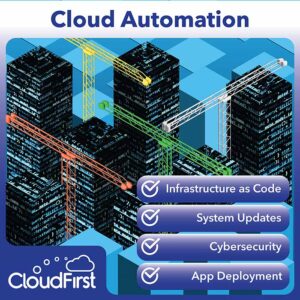How do you secure a cloud? When it comes to regular clouds, you can’t—they’re way up in the sky and are nothing but water vapor. Lucky for us, the cloud we’re talking about today is 100% more securable.
How to go about it is another matter. How can you automate the deployment and security of cloud infrastructure to build the best cloud computing environment possible?
First, let’s pin down what cloud infrastructure actually is. Cloud infrastructure refers to the components needed for cloud computing, including hardware, abstracted resources, storage, and network resources—everything you need to build a cloud. You can’t host services and applications without it.
Cloud infrastructure automation uses technology that performs tasks with reduced human involvement to control the hardware, software, networking components, operating system, and data storage components that deliver information technology services and solutions.
When you choose not to automate your cloud infrastructure, you’re subjecting your IT team to heaps of manual maintenance and configurations during deployment and system security.
That doesn’t have to be the reality for your team.
How automation helps you address cloud infrastructure deployment challenges

A prominent challenge with cloud infrastructure deployment is equipping yourself with the proper cloud migration plan. Without the right migration plan, your infrastructure deployment could crash and burn.
It can be overwhelming to configure the proper approach for deploying your cloud infrastructure while managing costs, keeping compliance in mind, and navigating complex architecture.
Most cloud environments operate on the Shared Responsibility Model, which adds a layer of complexity. Under this model, the cloud provider must monitor and respond to security threats related to the cloud itself and its underlying infrastructure, while the end users are responsible for protecting data and assets they store on the cloud.
Closing security gaps while keeping up with the speed of the cloud can be a particular challenge, not to mention a time-consuming one. But all is not lost.
“The rate of new security issues is significantly accelerated by how fast cloud resources can be provisioned,” says Kim Bozzella in Forbes. “To address that, organizations need to ‘bake’ security into their cloud blueprints and the cloud resource provisioning process, so the threat is mitigated at ‘Day Zero.’”
The right cloud deployment and security automation tool can help reduce the risks associated with these challenges and lead to a more robust cloud environment on a solid, secure foundation.
How? By simplifying deployment, staying one step ahead of bad actors, keeping pace with compliance regulations, automatically configuring migration strategies, and more.
Properly developed deployment automation means:
- Faster release cycles. Teams are free to ship updates more frequently.
- Reduced human errors. This is a standard benefit of automation.
- Improved reliability. Automation is by nature a consistent and repeatable tool.
- Increased efficiency. Developers and admins are free from manual work.
- Better collaboration. Automation improves visibility and collaboration across teams.
- Cost reduction. Save labor costs without sacrificing operational quality.
“An infrastructure automation framework delivers predictability and repeatability to those processes used for managing IT workload configuration across the organization,” says VMware. “This in turn helps IT meet their service level agreements (SLAs) by reducing complexity and freeing up valuable IT resources to focus on business value rather than low level infrastructure management.”
Tools such as Terraform, HCL BigFix, ezAutomate, Ansible, and more can help you achieve these results, but we’ll touch on those later.
First, let’s talk about how to come up with the right strategy for your organization.
Best practices for formulating a secure, repeatable strategy for deployment automation
Deployment automation uses software tools and systems to move changes in code from one software environment to another, eliminating the need for manual software releases.
When forming a secure deployment automation strategy, consider your company’s budget, timeline, and current level of automation. From there you can determine what steps to take to adopt an “automation first” mindset that will support a fully fleshed-out automated system instead of half-baked attempts at automation adoption that cause more issues than they solve.
Avoid hasty implementations and underresearched adoptions. The better your grasp on what your specific use case requires, the more likely you are to succeed when leveraging automation in your deployment process.
Taking the time to iron out a strategy leads to a more repeatable process. A frantic, cobbled together solution can be trickier to duplicate and is less likely to yield consistently positive results—the clearer the roadmap, the clearer the outcome.
Beyond that, faster deployment means faster fixes for any broken services. Automation tackles configuration and policies to allow for more efficient application and infrastructure function.
What tools to consider for deploying and securing cloud infrastructure

Deployment and security are both crucial aspects of setting your cloud up for success, and you’ll need the right tools in your arsenal.
To deploy and secure cloud infrastructure automatically, you’ll want to look at a few main options:
- Terraform for IBM, an infrastructure as code tool (IaC) great for infrastructure foundations
- HCL BigFix, endpoint protection automation software for hybrid environments
- VMware Cloud Foundation, a deployment solution combining the best of private and public clouds
- Ansible, an open-source IT automation engine that automates configuration management, application deployment, and so on
- ezAutomate, our automation solution for IBM Power Systems cloud and hybrid environments
An IaC solution allows you to provision and support your computing infrastructure using code instead of manual processes and settings, providing an additional layer of support in the foundation of your infrastructure.
Solutions such as Anisble—built on top of OpenShift—have clearly laid the groundwork for simplifying deployment while prioritizing security and compliance.
ezAutomate provides a single-console service complete with cloud gateway protection, automated server and endpoint security, network monitoring and administration services, and beyond.
Whatever you choose, get ready to reap the benefits of automated brilliance.
Ready to take your cloud infrastructure deployment from complex to simple?
Now that you know why deployment automation is a worthwhile investment, how to get started, and what tools are at your disposal, the next step is to pull the trigger on a plan that makes the most sense for your organization.
You know that deployment automation leads to:
- cost reductions
- better collaboration
- faster release cycles
- increased efficiency
You’ve already started contemplating your strategy for a smooth cloud infrastructure deployment process based on best practices.
Take action. Get in touch today to start the infrastructure deployment automation journey.

